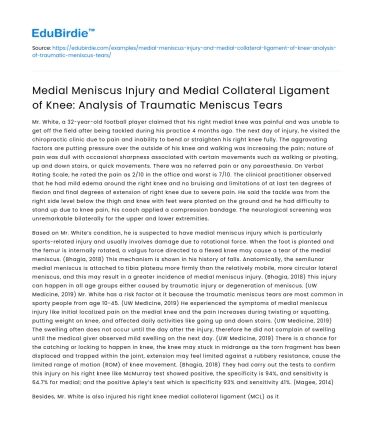Introduction
The knee joint, a pivotal point in human mobility, is often subjected to various injuries, with meniscus tears being notably prevalent. Traumatic meniscus tears, resulting from acute injury, are distinct from degenerative tears that occur due to aging. These tears pose significant challenges in orthopedic medicine, impacting athletes and older adults alike. Menisci, the crescent-shaped cartilages, act as shock absorbers between the femur and tibia, and their injury can lead to pain, swelling, and reduced mobility. Understanding the mechanisms, treatment options, and rehabilitation processes of traumatic meniscus tears is essential for effective management and recovery. This essay explores the intricacies of traumatic meniscus tears, delving into their causes, treatment modalities, and the debate over surgical versus conservative management.
Causes and Mechanisms of Traumatic Meniscus Tears
Traumatic meniscus tears are often the result of significant stress or force applied to the knee joint, typically encountered during athletic activities. Sudden twisting or pivoting motions, particularly when the foot is planted on the ground, can lead to tears. According to a study by McDermott and Amis (2006), such injuries are prevalent in sports like football, basketball, and soccer, where rapid directional changes are frequent. Moreover, direct impact to the knee, such as a tackle in rugby, can also cause meniscus tears.
Save your time!
We can take care of your essay
- Proper editing and formatting
- Free revision, title page, and bibliography
- Flexible prices and money-back guarantee
The anatomy of the knee joint plays a crucial role in the susceptibility to such injuries. The menisci, composed of fibrocartilaginous tissue, distribute weight and reduce friction during movement. In traumatic incidents, the medial meniscus is more commonly injured compared to the lateral meniscus due to its limited mobility and firm attachment to the tibial plateau. The blood supply to the meniscus, primarily from the peripheral "red zone," influences healing potential. Tears in the inner "white zone" often require surgical intervention due to inadequate blood supply for natural healing.
While traumatic tears are predominantly associated with younger, active individuals, they can occur in older adults due to increased participation in physical activities. This highlights the importance of preventive measures, including strength training and neuromuscular conditioning, to mitigate the risk of such injuries. Understanding these factors is crucial for developing effective prevention and rehabilitation strategies, thereby reducing the incidence and impact of meniscus tears.
Treatment Modalities: Surgical Versus Conservative Management
The management of meniscus tears continues to be a subject of debate in orthopedic circles, with treatment decisions often tailored to individual circumstances. Surgical intervention, particularly arthroscopic partial meniscectomy, is a common approach for treating meniscus tears. This minimally invasive procedure involves removing the damaged portion of the meniscus to alleviate symptoms and restore knee function. According to a study by Katz et al. (2013), patients undergoing surgery reported significant improvements in pain and mobility.
However, surgery is not without its risks and potential complications. Concerns about the long-term effects of meniscectomy, such as accelerated osteoarthritis, have led to increased interest in meniscus repair and preservation techniques. Furthermore, conservative management, including physical therapy and activity modification, has gained traction as an initial treatment strategy. Research by Sihvonen et al. (2013) suggests that in certain cases, non-operative treatment can yield comparable outcomes to surgical intervention, particularly in stable tears.
Counterarguments for conservative management often point to the risk of persistent symptoms and decreased knee function. Nonetheless, a patient-centered approach, considering factors such as age, activity level, and tear characteristics, is essential for optimizing treatment outcomes. The ongoing debate underscores the need for further research to establish clear guidelines for the management of traumatic meniscus tears.
Rehabilitation and Recovery: Keys to Successful Outcomes
Rehabilitation plays a pivotal role in the recovery process following a meniscus tear, regardless of whether surgical or conservative treatment is pursued. A comprehensive rehabilitation program focuses on restoring knee function, enhancing strength, and preventing future injuries. Early-stage rehabilitation typically involves reducing pain and swelling through rest, ice, compression, and elevation (RICE protocol), alongside gentle range-of-motion exercises.
As recovery progresses, emphasis shifts to strengthening exercises targeting the quadriceps and hamstrings, crucial muscle groups for knee stabilization. Proprioceptive training, which improves balance and joint awareness, is also integral to rehabilitation, particularly for athletes aiming to return to sports. A gradual return-to-activity plan, customized to the individual's progress and goals, ensures a safe transition back to normal activities.
Despite the benefits of rehabilitation, challenges such as adherence to exercise regimens and fear of reinjury can hinder recovery. According to a study by Ardern et al. (2014), psychological factors significantly influence rehabilitation outcomes, highlighting the importance of addressing mental health aspects in the recovery process. By fostering a holistic approach to rehabilitation, combining physical and psychological support, individuals are more likely to achieve successful outcomes and reduce the risk of recurrent meniscus injuries.
Conclusion
In conclusion, traumatic meniscus tears represent a significant challenge in the field of sports medicine and orthopedics, with implications for a diverse population. Understanding the causes and mechanisms of these injuries is crucial for devising effective prevention and treatment strategies. The ongoing debate between surgical and conservative management highlights the need for personalized treatment plans that consider individual circumstances and preferences. Rehabilitation, encompassing both physical and psychological components, is essential for optimizing recovery and preventing future injuries.
As research continues to advance our understanding of meniscus tears, it is imperative for clinicians to remain informed about the latest developments and integrate evidence-based practices into patient care. By doing so, healthcare providers can enhance treatment outcomes and improve the quality of life for individuals affected by traumatic meniscus tears. Ultimately, a comprehensive and patient-centered approach is essential for addressing the complexities of meniscus injuries and promoting successful recovery.






 Stuck on your essay?
Stuck on your essay?

